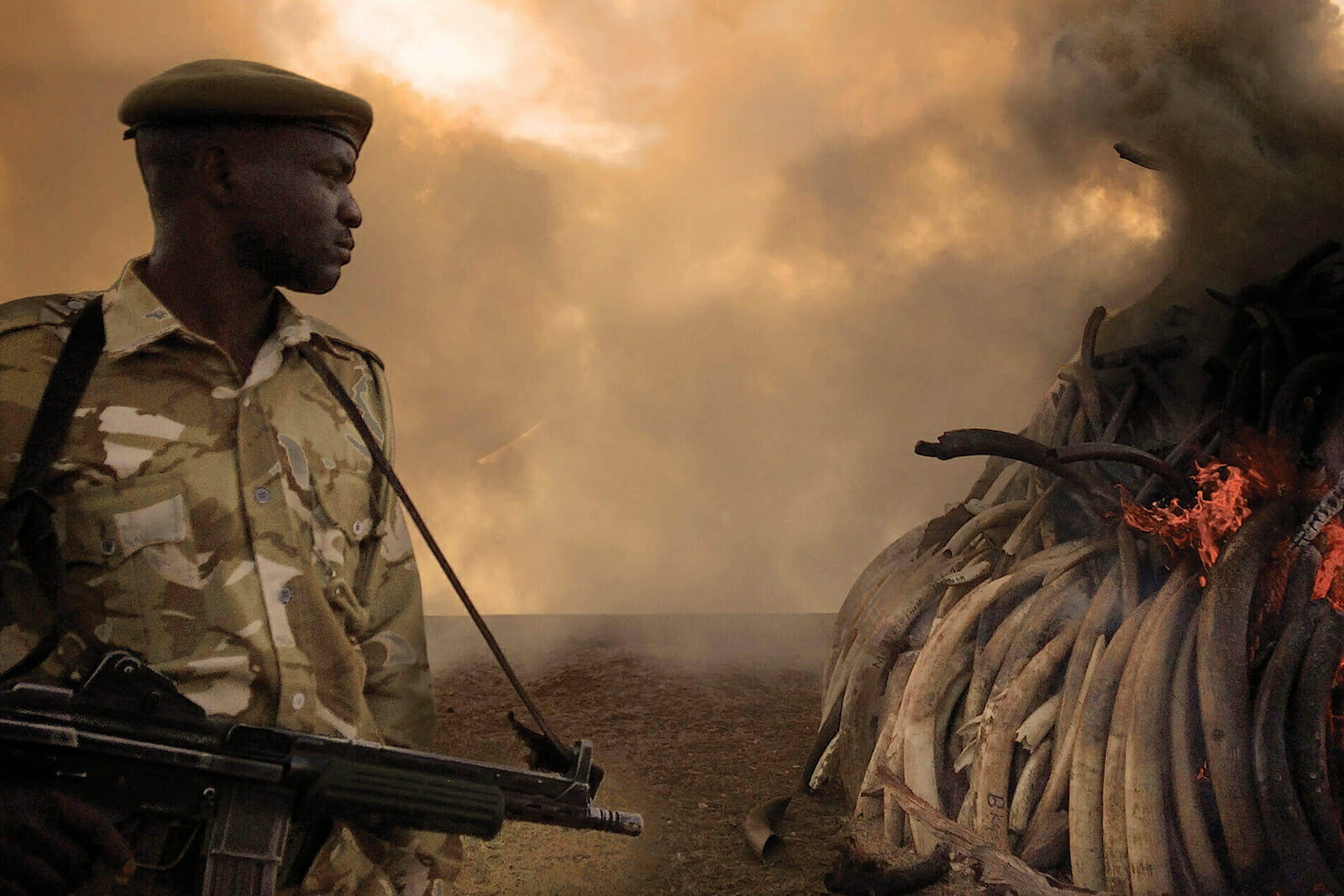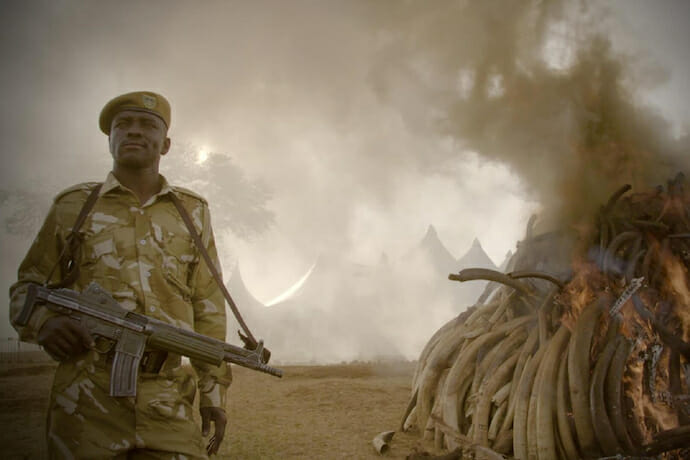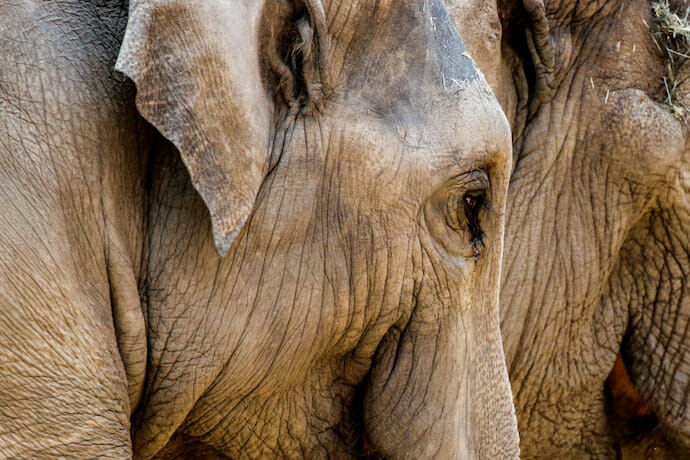
A Spectre of Corruption: The ‘Shetani’ Ivory Case
It began as a whisper. An ambiguous and innocuous headline, “Court acquits two once jailed suspect poachers”. Hardly the attention-grabbing title one might expect when an internationally infamous ivory trafficker, with the demonic moniker of Shetani Hana Huruma (Swahili for “The devil without Mercy”), has his original conviction quashed by the highest court in the land.
On June 18th, 2020, the Chief Justice of Tanzania, Ibrahim Juma, leading a quorum of three, ruled that “The appeal has merit and it is hereby allowed. The conviction against the two appellants is quashed, and their respective sentences are set aside.” On that note, Boniface Mathew Malyango, and his brother, Lucas, were released 4 years and 9 months into their ten-year sentence. They had been charged with leading an organized crime network and unlawfully dealing in wildlife trophies.
It took six weeks for that news to make it to the state-owned The Daily News, ducking under the radar of normally eagle-eyed wildlife NGO’s and elephant-related news feeds. Even then, it took another nine months for the story to garnish any media attention at all, and just a blip at that.
The quashed conviction of this ivory trafficker, one made infamous through Leonardo Di Caprio’s award-winning documentary film, The Ivory Game; a man alleged to have killed 10,000 elephants; who ran 15 ivory poaching networks in five different countries; labeled as the most prolific ivory poacher and trafficker in East Africa; and the major supplier of weapons, ammunition, and cars to poachers, had been quietly set free.
How could this be? At the time of Malyango’s arrest, an anonymous senior Tanzanian government official was quoted as saying: “the evidence we have against Shetani is crushing.” A year later, audiences were watching Shetani’s actual arrest near his home in Dar es Salaam caught on film by an embedded camera crew. The filmmakers later stated: “With this film, we will be able to reveal real incriminating evidence against traffickers across the entire supply chain, including direct links between the ‘Queen of Ivory,’ (66-year old Chinese national, Yang Feng Glan, charged with trafficking 1.8 tonnes of ivory) Shetani and networks of international traffickers across Asia and China.”
But in the end, from a criminal justice perspective, it was all for naught. The highest court in the land, in a second appeal, presided over and written by the Chief Justice of Tanzania, ruled that the state could not prove any of the elements of the charge; that Malyango and his brother, “between 1st January 2009 and 23rd October 2015…jointly and willfully organized and managed a criminal racket. This involved collecting, transporting, and selling government Trophies, that is, 118 elephant tusks.”

To all those who follow international wildlife crime and/or watched The Ivory Game, surely the first thought, the inside voice, was quietly screaming, “corruption.” How does a prosecution go from “crushing evidence” to essentially no evidence? How do the arrests of poachers with firearms and/or ivory, captured on camera not translate into “collecting”? How does the discovery of hidden compartments in motor vehicles, captured on camera, not show “transporting”? How does a phone data organizational chart, captured on film, not indicate a “criminal racket”? And what of the 118 elephant tusks?
While international media coverage of Malyango’s initial arrest was widespread, coverage of the trial, certainly outside Tanzania, did not happen. The ruling on his conviction in March of 2017 was reported. His first failed appeal in October 2018 was also reported, being “dismissed in its entirety.” And even to date, with his quashed conviction having now just come to light, details of what happened are scant and translucent. Unsurprisingly, as seen with most acquittals in major wildlife cases, the initial reactions on causal factors focused on lack of specific training or overall capacity, crime scene and evidence continuity challenges, and prolonged trials. Corruption has been in the discussion, but in general terms only, particularly in relation to other failed major cases of which Kenya predominantly features.
Corruption in high-level wildlife prosecutions, the Feisal Mohamed Ali case aside, is rarely obvious. When corruption is seemingly evident, the easiest conduit for blame is the police, the lowest rung on the ladder of criminal justice. We as a society, generally have difficulty with the concept that lawyers, prosecutors, magistrates, justices, those who have typically come from more elevated socio-economic backgrounds, or who are perceived as representing the cream of our societies, and who have attended years of post-secondary education, could ever choose greed and personal economics over integrity and justice. The reality, however, is very different. Corruption likes the shadows and hides particularly well behind the “discretionary” rulings of Judges and Magistrates. The judiciary is subject to the same human frailties as everyone else.
Anomalies
The Shetani case presents a number of anomalies that bear examining. Each anomaly, on its own, may seem innocuous. Together, the picture is different. Let’s go back to the first thought on most person’s minds when learning of the quashed conviction.
It needs to be said from the outset that this investigation and the arrest of Boniface Mathew Malyango aka “Shetani” was conducted by officers of the National and Transnational Serious Crimes Investigation Unit (NTSCIU). The NTSCIU are not the regular police but a unit of handpicked officers from law enforcement and the military. There is, within the NTSCIU, an anti-poaching component and they have credentials. Since approximately 2014, and supported by the PAMS Foundation (a Tanzanian non-profit that aims to empower people who protect wilderness and wildlife), they have accrued an impressive list of arrests with convictions, including that of the “Ivory Queen,” and a previous arrest of Malyango in June 2014. And while The Ivory Game may have, with cinematic and artistic license, cemented that reputation, a closer look will question whether it was, in fact, their finest hour.
No Ivory
In essentially all wildlife trafficking prosecutions, suspects are arrested with quantities of “trophies.” The worst nightmare, particularly in a major investigation, is to have a “bust” without “product.” This is the situation that befell the Shetani arrest. In what may well be a first in the annals of ivory trafficking investigations, a key player was arrested with no physical ivory in his possession.
The global perception that Shetani was, at the very least, directly connected to a stash or seizure of 118 ivory tusks was incorrect. There were no tusks found in his home, the home of his brother, the home of his witch doctor nor was there any indication that ivory tusks were found anywhere else in relation to this investigation, including vehicles. This case was devoid of tusks. The figure of 118 tusks was an abstract and came solely from “oral confessions” and the cautioned statement made by Malyango post-arrest.

With the Shetani arrest yielding no substantive amount of ivory, there were many unanswered questions. Did investigators believe that they would find ivory tusks? If they did not, did they believe there was enough evidence to meet the prosecution threshold of “beyond a reasonable doubt”? Did they really have “crushing evidence” or was it “crushing intelligence”? Was there outside pressure pushing investigators for an arrest; perhaps related to the upcoming national election or the documentary production? Could there have been an unknown force in play taking advantage of the absence of the NTSCIU’s Chief, Elisifa Ngowi (he was in Arusha), to manipulate a premature arrest?
Vehicle Searches and “Whitish Particles”
The prosecution had to rely on other evidence. This other evidence, meant to prove to the court that Malyango and his brother were “collecting, transporting and selling government trophies,” amounted to three oral confessions, one cautioned statement, and “whitish particles” found in the back of a Honda CRV. Despite the “whitish particles” later being analyzed as ivory, this evidence was eliminated by the Appeal Court due to anomalies in its collection.
It is known that Malyango was arrested on October 23rd between 9 am and 10 am near his Dar es Salaam home. He was taken initially to his home where his Honda CRV vehicle was also located. The CRV was later driven to NTSCIU headquarters (approximately 12km) and subject to search by canine. At approximately 16:45 hours, the dog indicated on the whitish particles which were seized and placed in an envelope.
While a senior officer testified that this was the only search conducted on the CRV, another officer at the arrest scene, testified to the contrary that he opened the CRV in the presence of the accused and saw “pieces of white things” in the back. The issue of the search was further complicated by the fact that the police had no record as to who specifically drove the CRV from the home to NTSCIU headquarters. This action was interpreted by the court in these circumstances as breaking the custodial chain. The prosecution argued that the CRV had been part of a police convoy thereby making unnoticed interference nearly impossible. The court, however, saw the ivory particles as being such a size that they could have easily changed hands. With this possibility of interference being raised, one cannot ignore the fact that ivory shards were apparently found in Malyango’s Honda CRV only. There was no similar evidence in the two other seized vehicles, one being a Mitsubishi Canter truck, alleged to have been used in ferrying poached ivory around the country.
Comparing the evidence handling in this seizure with others by Tanzanian law enforcement sees a marked difference. In the first arrest of Malyango in June 2014, the NTSCIU seized 326 kilogrammes of ivory from eight suspects and their evidence handling was faultless. The same was said relating to a November 5th, 2015 arrest of four Chinese nationals found with 53 kilogrammes of rhino horn in their Toyota Hilux that also passed the scrutiny of the Appeal Court of Tanzania.
Confessions and Cautioned Statement
Malyango made three oral confessions to three different NTSCIU investigators and provided a cautioned statement to a fourth on November 29th, 2015. Based on NTSCIU prior practice, the obtaining of a cautioned statement over one month from the time of arrest would be considered an anomaly. In previous arrests, including from all accused of the Ivory Queen prosecution, cautioned statements were obtained within 24 hours.
Cautioned statements taken from an accused ivory trafficker are not the norm amongst many of the law enforcement agencies that investigate such. If a cautioned statement is taken, it is typically handwritten. In circumstances where it is being tendered into evidence before a court, it must be clear to the presiding magistrate that the accused who made the statement was aware of two things; that they were giving evidence against themselves and that it was voluntarily obtained without threat or inducement by persons deemed to be in authority.
The confessions of Malyango became the basis and grounds on which NTSCIU arrested and charged Malyango’s brother Lucas, as well as Abdalah Ali Chaogi, Malyango’s witch doctor (amongst other inflictions, Shetani was being treated for erectile dysfunction). Also based on these statements, searches were conducted at a number of other locations around Tanzania. There is no reference to the recovery of any additional inculpatory evidence.
The trial magistrate, Resident Magistrate E. Fovo, accepted the oral confessions and the cautioned statement into evidence. Judge J. Kalombola of the High Court of Tanzania, however, while ruling that the appeal was without merit, expunged the cautioned statement, finding that the trial magistrate had not fulfilled the legal obligation of ruling on the voluntariness of that statement. The Chief Justice went further in the last appeal by stating that while the “oral confessions of guilt are admissible and can be acted upon, but we also emphasize that great caution is required before courts rely on oral confession to convict.” The Chief Justice continued by stating that independent of the concerns on the admissibility of statements, neither the cautioned statement nor the oral confessions provided the required ingredients to prove the charges before the court.
More questions abound. Why did NTSCIU wait for one month to obtain a cautioned statement from Malyango? How did the trial magistrate overlook the most basic of legal requirements by not ruling on the admissibility of a cautioned statement from the primary accused? Did not Malyango’s advocate bring that to the attention of the court? How is it that despite taking four different confession statements, none of the statements provided direct and specific evidence of the elements for which Malyango was charged? The officers involved were seasoned and/or senior with one, in particular, Detective Sergeant Beatus, having taken cautioned statements in other high-profile prosecutions.
A Tale of Two Prosecutions
A comparative look at the prosecutions of the Ivory Queen and Shetani will find few similarities. In the Ivory Queen case, cautioned statements were taken from all accused within 12 hours of arrest. In the Shetani case, the cautioned statement was obtained five weeks from the arrest date, seemingly almost as an afterthought, perhaps taken on the realization that evidence to convict was scant.
In the Ivory Queen case, the presiding magistrate had an inquiry on the voluntariness of each of those cautioned statements, stating that “proper procedure and law directs that we should conduct an inquiry on the matter whether the statement was voluntarily given or not.” In the Shetani case, there was no inquiry as required by statute resulting in the higher court expunging the statement.
In the Ivory Queen case, independent witnesses testified as to having seen the movement of ivory tusks between the three co-accused and deliveries by taxies and lorries from and to specific locations (including her restaurant). These witnesses also described how the Ivory Queen had the ivory weighed on receipt and where it was hidden. There was the testimony of ivory being delivered to Chinese naval ships in Tanzanian military lorries. In the Shetani case, there were no independent witnesses to testify about any ivory. Instead, officers recounted generalized admissions taken from statements like: “Boniface told us that he owned that car [Mitsubishi Canter] but handed it over to his brother for taking care of the ivory business.”
In the Ivory Queen case, prosecutors presented documentary evidence, obtained from banks, of financial transactions between the co-accused. There was no financial evidence submitted in the Shetani case.
In both prosecutions, state attorney’s prepared charge sheets for “leading an organized crime network” and “unlawfully dealing in wildlife trophies.” The Ivory Queen case presented real evidence to support the charges. In the Shetani case, prosecutors conceded before the Chief Justice that “the charge sheet was prepared with the hope that the evidence of the cautioned statement would prove the transaction involving 118 elephant tusks.”
Political Expediency over Rule of Law
While there is no dispute as to the factual guilt of Boniface Mathew Malyango, his legal guilt is another question. How does one look at the Shetani case and not wonder if there was consideration to the principle of “reasonable prospect of conviction” prior to charging? How does one not speculate on whether the judicial process was pre-determined at some point, even perhaps before arrest?
From the perspective of political expediency, this case is very similar to that of Feisal Mohamed Ali, initially convicted in Kenya in 2016 of charges relating to his trafficking of 2.2 tonnes of ivory. Just months before his sentencing, President Kenyatta proclaimed to the world, while setting ablaze 105 tonnes of ivory, that “poachers and their enablers will not have the last word in Kenya.” This was during a time when Kenya’s first lady was patron to the very successful “Hands Off Our Elephants” campaign and Kenya was positioning itself to take a lead role in the upcoming CITES meetings in South Africa. Feisal was convicted as the world expected, only to have his conviction overturned on appeal two years later for a host of valid reasons.
Tanzania found itself in the spotlight around the same time but for totally different reasons. Castigated internationally for allowing two-thirds of its elephant population to be massacred, Tanzania needed high-profile arrests and convictions. Coincidentally or otherwise, within a six-week period surrounding President Magafuli’s election win, three very high profile wildlife trafficking arrests were made by Tanzanian enforcement; Yang Feng Glan, Boniface Malyango, and the four Chinese nationals with 53 kilogrammes of rhino horn. These were seen as important indicators that Tanzania was turning around in its fight against transnational organized crime and wildlife trafficking. The fact that five of the accused were Chinese nationals made the response seem even more emphatic; the arrest of Shetani captured on camera before an international audience, even more so.
Everything being considered, it is difficult to envisage President Magufuli, elected on a platform of anti-poaching and anti-corruption, permitting an acquittal on his watch.
As it is played out, and certainly in the short term from a wildlife crime perspective, Tanzania’s no-nonsense approach to poaching and trafficking has paid off. The Chinese cartels have moved out of Tanzania to the far safer haven of Nigeria and the local traffickers are keenly aware that should they get found or even suspected, they will be going to jail, one way or another.
Boniface Malyango and his brother spent almost five years in jail before the inevitable quashed conviction was registered. The Ivory Queen and her co-accused were sentenced to 15 years in jail each (it is anyone’s guess as to whether she is still in jail). Her two co-accused, Manase Philimon, and Salivius Matembo did not make initial bail and were in jail for 18 months before that trial even began. Their appeal to the High Court was struck down. The four Chinese nationals with 53 kilogrammes of ivory were all initially convicted to 15 years in jail with massive fines. The conviction of three of the four was quashed at Appeal Court but the 20-year jail sentence and a massive fine of the vehicle owner, Song Lei, upheld.
The Shetani quashed conviction is not about lack of institutional capacity, crime scene management failures, or prolonged trial issues. The court of common sense would indicate it is about evidence, rule of law, and political expedience cloaked in judicial discretion. In some circles, this is also known as corruption.

